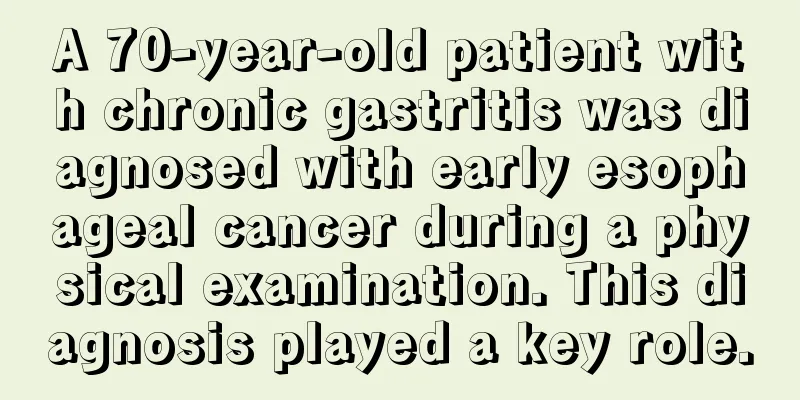A 70-year-old patient with chronic gastritis was diagnosed with early esophageal cancer during a physical examination. This diagnosis played a key role.

|
For tumor diseases, we have always emphasized early detection and early treatment, and the key point is to detect potential abnormal symptoms in time, and to conduct targeted examinations to find the lesion area. However, early tumors may have no symptoms. For example, early dysplasia of esophageal cancer may not cause burning or chest pain. How should it be discovered? In April this year, our hospital treated a patient with early esophageal cancer. She is a typical example of early asymptomatic manifestations. So how did the patient discover the lesion? Case sharing: Symptom examination: Gastroscopy revealed that the posterior wall of the esophagus was slightly edematous at 16-20 cm from the esophagus, with a little white fur on the surface. NBI: The mucosa was brown, iodine staining: 16-20 cm, the mucosa at 5-8 o'clock was not colored. How to detect early esophageal cancer in the golden period <br/>Early diagnosis and treatment is recognized as the golden period for the treatment of esophageal cancer and other tumor diseases. The patient Ms. Sun in the above case was lucky to discover the lesion and took regular treatment. The question we want to discuss is how to detect early cancer when there are no symptoms. Key items for diagnosing early esophageal cancer <br/>From the above cases, we can clearly see that gastroscopy plays a vital role in the diagnosis and treatment of early esophageal cancer. Whether there are obvious symptoms or no symptoms, the digestive system organs are inside the body. Simply relying on physical examination, blood test, and tumor cell detection cannot accurately determine the condition; moreover, early dysplasia and tumor properties require pathological testing. If you cannot enter the organs, you cannot collect pathological samples. |
>>: How to treat advanced renal cancer? Mainly drug treatment
Recommend
What is the basis for ovarian tumor diagnosis
Ovarian tumor refers to a tumor that occurs on th...
How long will it take for my body to itch after taking tuberculosis medicine
Tuberculosis is very common in life. It is a vira...
What tests are needed for lung cancer? Three tests that lung cancer patients must do
I'm afraid that people are most reluctant to ...
Average life expectancy in late-stage gallbladder cancer
Many people are concerned about how long patients...
What are the symptoms of neuritis?
Neuritis actually encompasses many conditions, so...
What is the reason for negative blocking antibodies
There are actually many reasons for negative bloc...
Diagnosis of laryngeal cancer
Anyone who has unexplained hoarseness, foreign bo...
Is it good to apply lemon water on your face?
Applying lemon water on your face can whiten your...
Mint treats rhinitis
Mint is a stimulating food ingredient. It can coo...
What are some great uses for old down jackets?
Every winter, many people will buy down jackets. ...
What are the complications after total gastrectomy for gastric cancer?
Gastric cancer patients can survive for several m...
Analysis of the main causes of ovarian cancer in women
What is the cause of ovarian cancer in women? In ...
7 major causes of severe hair loss after autumn
Autumn is a season of harvest, but for those who ...
Can I eat soy sauce if I have a scar on my face
People who have scars on their faces due to vario...
Steps for hand brewed coffee
Nowadays, coffee has become a drink that many peo...









